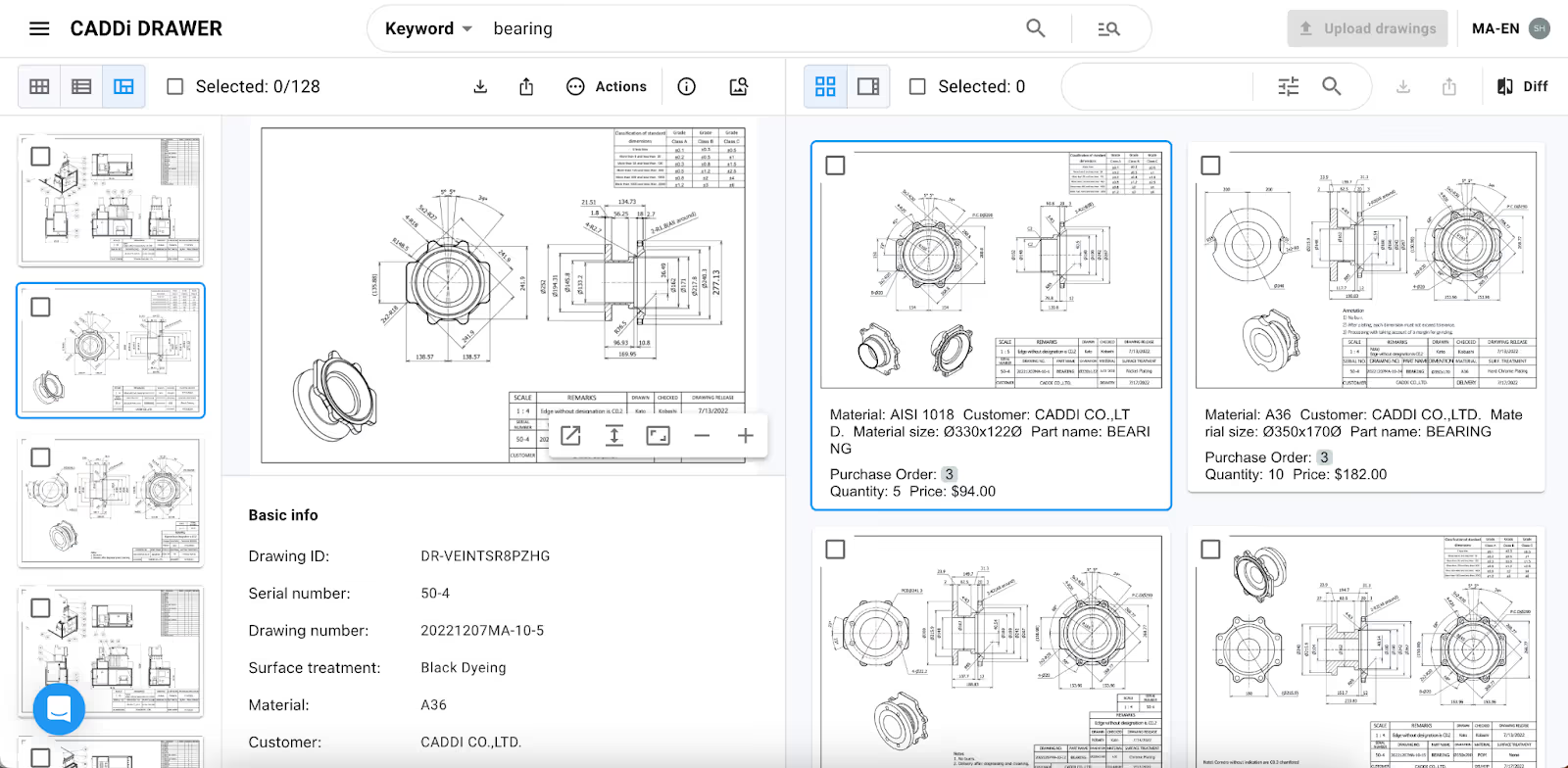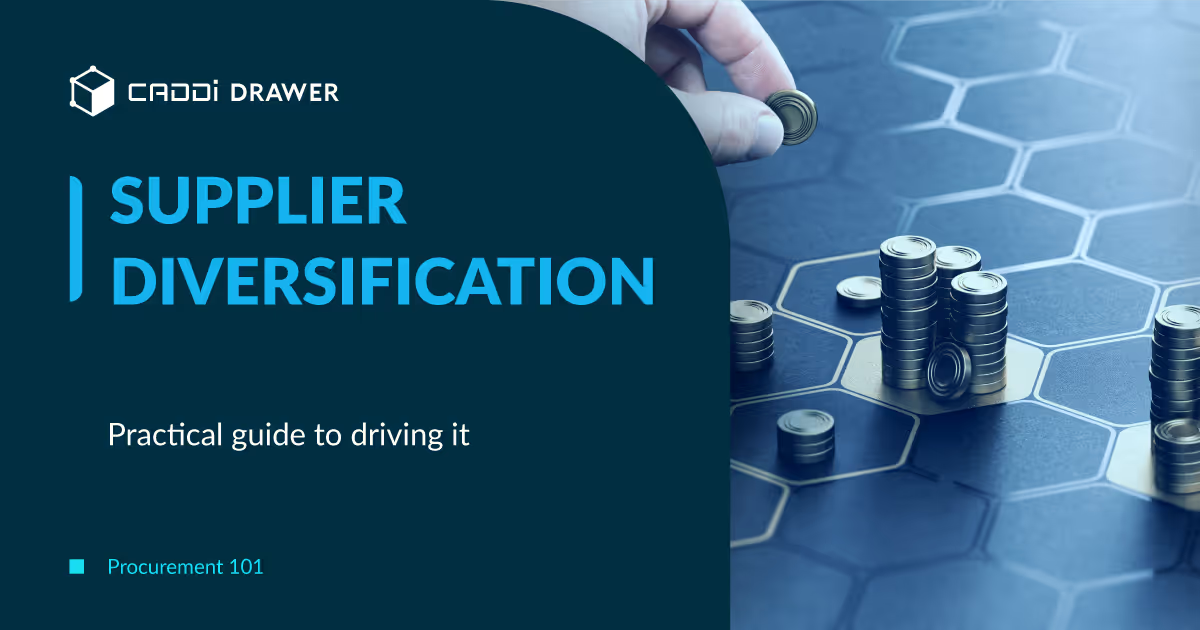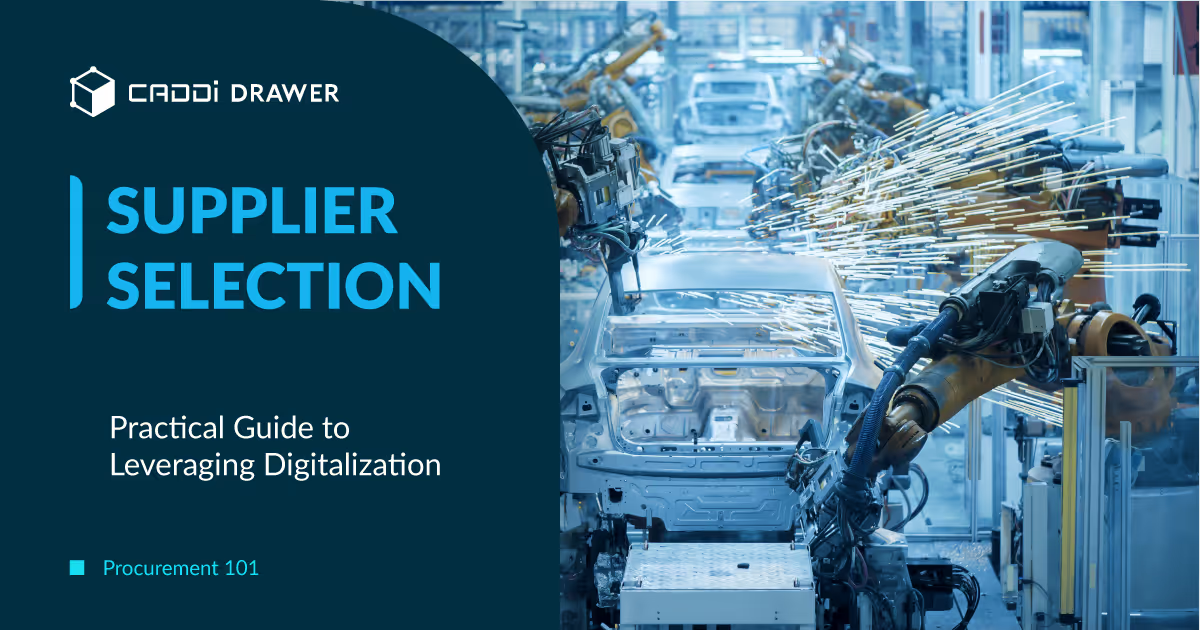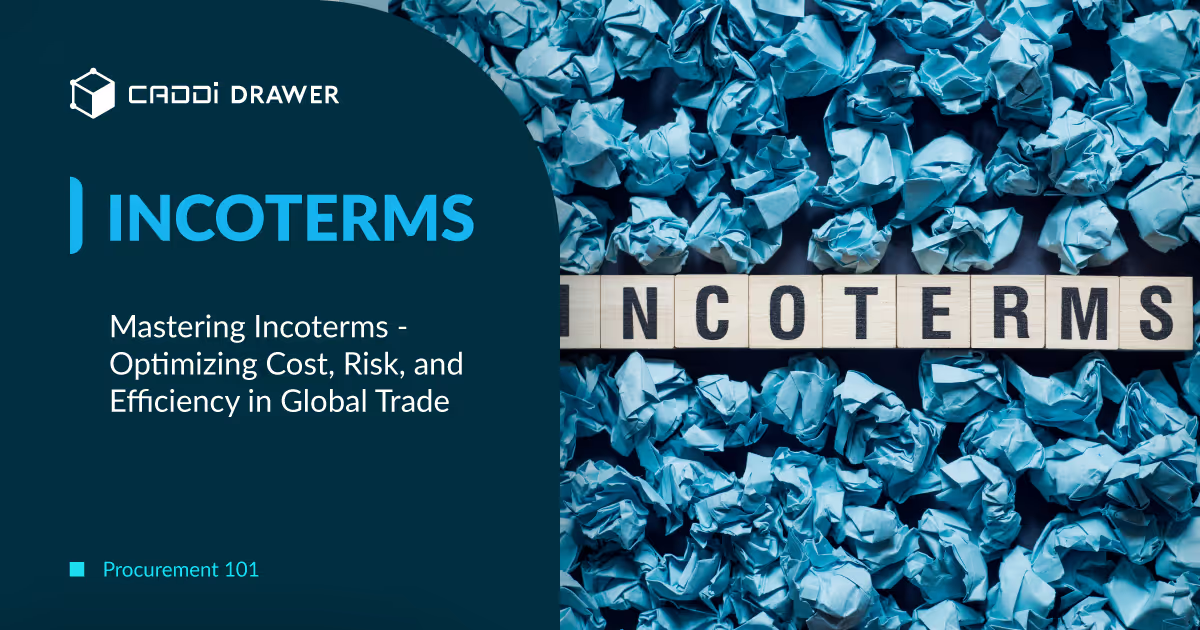Procurement 101: Procurement Intelligence for smarter sourcing decisions

Table of Contents

What is Procurement Intelligence?
Procurement intelligence is a revolutionary concept that is transforming the way manufacturers approach sourcing decisions. Drawing inspiration from other fields such as sales intelligence and business intelligence, procurement intelligence is quickly becoming the new standard for supply chain management.
It’s about leveraging data to make smarter, more informed decisions. It’s like having a supercomputer that can analyze vast amounts of information and provide actionable insights in real-time. By harnessing the power of advanced analytics, artificial intelligence, and machine learning, procurement professionals can:
- Cost Optimization: Quickly identify cost optimization opportunities without lengthy data collection and analysis.
- Supplier Identification: Identify the best suppliers based on criteria like cost, quality, reliability, and sustainability.
- Contract Negotiation: Negotiate favorable contract terms and pricing using data-driven insights.
- Empowering Team: Leverage shared organizational knowledge, reducing reliance on individual experience and tribal knowledge, to improve procurement capabilities.
From Gut Instinct to Data-Driven Decisions
In the past, procurement decisions were often based on memory, gut instinct, and limited data, like navigating an unfamiliar city with a paper map. However, procurement intelligence is revolutionizing supply chain management, just as GPS technology has transformed the way we travel.
Existing procurement software is like outdated car navigation systems that relied on old information and couldn’t always provide the best route. In contrast, procurement intelligence is akin to real-time, internet-connected route guidance on modern smartphones and cars.
Procurement intelligence leverages these technologies to help manufacturers make optimal sourcing decisions like modern navigation systems that use advanced algorithms and AI to analyze real-time traffic data and provide the fastest, most efficient route at speeds and accuracy levels unattainable by humans.
There’s no need to rely on memory or past paper documents for supplier selection and price evaluation; with procurement intelligence, analysis and judgment can be made using the latest, most accurate data, processed by cutting-edge algorithms.
Key Components of Procurement Intelligence
Procurement intelligence is a powerful approach that leverages data from existing systems such as ERP and PLM, as well as other sources like drawings and scattered files. It’s important to note that procurement intelligence does not replace these systems; instead, it aggregates and utilizes information from multiple data sources to provide a comprehensive view of the procurement landscape.
Now, let’s explore the core data points that procurement intelligence encompasses:
Procurement Data encompasses all the information related to the organization’s purchasing activities, including spend analysis, supplier performance, and contract management. This data helps procurement teams identify opportunities for cost savings, improve supplier relationships, and ensure compliance with internal policies and external regulations.
- Spend by category, supplier, and department
- Supplier performance metrics (quality, delivery, cost)
- Contract terms and conditions
Engineering Data, extracted from PLM systems and drawings, provides essential information about product specifications, materials, and manufacturing requirements. This data helps procurement teams ensure that suppliers can meet the necessary quality standards and deliver components that conform to the design intent.
- Product specifications and tolerances
- Material requirements
- Component dimensions and geometries
- Assembly instructions
- Design review and revision history
Supply Chain Data provides crucial information about the flow of goods and services from suppliers to the organization. This data helps procurement professionals identify potential risks, optimize processes, and make informed decisions.
- Supplier lead times
- Order fulfillment rates
- Shipping and delivery times
- Inventory levels
- Supplier capability and capacity
Manufacturing Value Chain Data offers insights into the various stages of the production process, from raw materials to finished products. This information enables procurement teams to identify opportunities for cost savings and process improvements.
- Bill of Materials (BOM) data
- Production schedules
- Cycle times
- Yield rates
- Quality control data
Demand Data helps procurement professionals forecast future requirements and ensure that the organization has the necessary supplies to meet customer needs. By analyzing historical sales data and market trends, procurement teams can make informed decisions about inventory levels and supplier contracts.
- Sales forecasts
- Historical sales data
- Market trends and seasonality patterns
- Product life cycle data
Raw Material Market Data provides valuable information about the availability, quality, and pricing of key inputs used in the manufacturing process. By monitoring market conditions and supplier performance, procurement teams can mitigate risks and ensure a stable supply of critical materials.
Raw material market data includes:
- Commodity prices
- Supply and demand trends
- Geopolitical risks
By leveraging these core data points from multiple sources, procurement intelligence empowers organizations to make informed decisions, optimize their supply chains, and drive value for their stakeholders.
Key Use Cases of Procurement Intelligence
Procurement intelligence offers numerous applications that can help organizations optimize their supply chain, reduce costs, and mitigate risks. By leveraging the power of data and advanced analytics, procurement teams can make informed decisions and drive continuous improvement. Here are some of the main use cases of procurement intelligence and how its outputs can be utilized:
1. Identify strategic suppliers
Procurement intelligence enables organizations to create an ideal supplier profile by analyzing their current supplier base and leveraging data to find suppliers that fit the desired criteria. By using procurement intelligence to identify suppliers that align with the organization’s strategic objectives, such as cost reduction, innovation, or sustainability, procurement teams can build a more resilient and efficient supply chain.
Example: If a company is looking for suppliers with expertise in sustainable packaging materials, procurement intelligence can help identify suppliers that meet these criteria by analyzing data from various sources, including supplier databases, industry reports, and sustainability ratings.
2. Consolidate and leverage data from various systems
By integrating ERP and PLM data into procurement intelligence platforms, organizations can consolidate and cross-reference information from various systems, enabling procurement teams to gain a holistic view of their supplier base and make data-driven decisions. This aggregation of data from multiple sources allows for more comprehensive analysis and insights, which can lead to improved supplier management and risk mitigation.
Example: By feeding supplier information from ERP and PLM systems into a procurement intelligence platform, procurement professionals can access consolidated data on supplier performance, financial stability, and risk assessments. This enables them to identify potential issues, optimize supplier relationships, and make informed decisions based on a comprehensive understanding of their supply chain.
3. Supplier performance risk assessment
Procurement intelligence enables organizations to assess and monitor supplier performance risks by analyzing data such as defect rates, on-time delivery rates, and other KPIs. By identifying potential issues related to quality deterioration or suboptimal supplier allocation, procurement teams can take proactive measures to mitigate disruptions and ensure a more reliable supply chain.
Example: If a procurement intelligence platform detects a trend of increasing defect rates or declining on-time delivery rates from a specific supplier, the procurement team can investigate the underlying causes, engage with the supplier to address the issues, and make informed decisions about supplier allocation to minimize the impact on product quality and customer satisfaction.
4. Negotiate better contracts
Procurement intelligence provides valuable insights into market trends, price benchmarks, and supplier performance, empowering procurement professionals to negotiate more favorable contracts. By leveraging data-driven insights, procurement teams can identify opportunities for cost savings, secure better terms, and build stronger supplier relationships.
Example: During contract negotiations, procurement intelligence can provide data on market prices for specific materials or components, enabling the procurement team to negotiate more competitive rates and ensure that they are receiving fair value from their suppliers.
5. Drive continuous improvement
Procurement intelligence provides a foundation for continuous improvement by enabling organizations to track KPIs, benchmark against industry standards, and identify areas for optimization. By regularly monitoring procurement data and leveraging insights from procurement intelligence platforms, organizations can drive ongoing improvements in their supply chain and procurement processes.
Example: If procurement intelligence reveals that a specific category of spend is consistently higher than industry benchmarks, the procurement team can investigate the root causes and implement strategies to reduce costs, such as consolidating suppliers or renegotiating contracts.
By leveraging procurement intelligence across these use cases, organizations can make data-driven decisions, optimize their supply chains, and achieve strategic objectives such as cost reduction, risk mitigation, and continuous improvement.
CADDi Drawer – A Key Solution for Procurement Intelligence
As mentioned earlier, one of the solutions that cover the general use cases is CADDi Drawer, which:
- Extracts information from drawings, which are image files, i.e., unstructured data that need to be handled and viewed by people, and converts it into structured data.
- Associates various information such as purchasing data, supplier data, quality and manufacturing-related documents with drawings, elevating information that is difficult to utilize when scattered into valuable data assets.
- Enables quick searching, grouping, listing, outputting, and further adding information to the accumulated data assets from various perspectives.
It may seem simple, but until now, there was no mechanism to achieve this. Considering the enormous amount of time procurement professionals have spent gathering, analyzing, and making judgments based on this data, one can imagine the magnitude of the impact.
These features provide powerful support for procurement professionals in the five use cases. Particularly powerful is the high-precision similarity search function. Unlike common image-based similarity judgments based solely on appearance, it recognizes the shapes of products and parts depicted in drawings before making similarity judgments, enabling it to find similar drawings that other software cannot extract.

This significantly streamlines the basic actions of procurement intelligence, such as grouping parts, gathering highly relevant past data, and constructing data-driven logic for analysis and negotiation.
As a result, the procurement department can:
- Allocate more time to essential analysis, strategic consideration, and execution of initiatives.
- Frequently implement cost optimization and other initiatives that were previously too burdensome to collect and organize data for, achieving true continuous improvement.
Manufacturers of industrial machinery and equipment, such as Kawasaki Railcar Manufacturing and Ebara Corporation, are actually utilizing these features of CADDi Drawer to successfully implement procurement intelligence in their strategic initiatives.
- Kawasaki Railcar Manufacturing: Unlocking the Potential of Hidden Drawings and Purchasing Data: Achieving Unexpected Cost Reductions
- Ebara Corporation: From “Drawing Management” to “Drawing Utilization”: Leveraging Buried Data for Optimal Procurement
The future of procurement lies in the ability to leverage data and technology to make smarter, faster, and more informed decisions. Procurement intelligence represents a paradigm shift in the way manufacturers approach sourcing, enabling them to optimize their supply chains, reduce costs, mitigate risks, and drive continuous improvement.
What is Procurement Intelligence?
Procurement intelligence is a revolutionary concept that is transforming the way manufacturers approach sourcing decisions. Drawing inspiration from other fields such as sales intelligence and business intelligence, procurement intelligence is quickly becoming the new standard for supply chain management.
It’s about leveraging data to make smarter, more informed decisions. It’s like having a supercomputer that can analyze vast amounts of information and provide actionable insights in real-time. By harnessing the power of advanced analytics, artificial intelligence, and machine learning, procurement professionals can:
- Cost Optimization: Quickly identify cost optimization opportunities without lengthy data collection and analysis.
- Supplier Identification: Identify the best suppliers based on criteria like cost, quality, reliability, and sustainability.
- Contract Negotiation: Negotiate favorable contract terms and pricing using data-driven insights.
- Empowering Team: Leverage shared organizational knowledge, reducing reliance on individual experience and tribal knowledge, to improve procurement capabilities.
From Gut Instinct to Data-Driven Decisions
In the past, procurement decisions were often based on memory, gut instinct, and limited data, like navigating an unfamiliar city with a paper map. However, procurement intelligence is revolutionizing supply chain management, just as GPS technology has transformed the way we travel.
Existing procurement software is like outdated car navigation systems that relied on old information and couldn’t always provide the best route. In contrast, procurement intelligence is akin to real-time, internet-connected route guidance on modern smartphones and cars.
Procurement intelligence leverages these technologies to help manufacturers make optimal sourcing decisions like modern navigation systems that use advanced algorithms and AI to analyze real-time traffic data and provide the fastest, most efficient route at speeds and accuracy levels unattainable by humans.
There’s no need to rely on memory or past paper documents for supplier selection and price evaluation; with procurement intelligence, analysis and judgment can be made using the latest, most accurate data, processed by cutting-edge algorithms.
Key Components of Procurement Intelligence
Procurement intelligence is a powerful approach that leverages data from existing systems such as ERP and PLM, as well as other sources like drawings and scattered files. It’s important to note that procurement intelligence does not replace these systems; instead, it aggregates and utilizes information from multiple data sources to provide a comprehensive view of the procurement landscape.
Now, let’s explore the core data points that procurement intelligence encompasses:
Procurement Data encompasses all the information related to the organization’s purchasing activities, including spend analysis, supplier performance, and contract management. This data helps procurement teams identify opportunities for cost savings, improve supplier relationships, and ensure compliance with internal policies and external regulations.
- Spend by category, supplier, and department
- Supplier performance metrics (quality, delivery, cost)
- Contract terms and conditions
Engineering Data, extracted from PLM systems and drawings, provides essential information about product specifications, materials, and manufacturing requirements. This data helps procurement teams ensure that suppliers can meet the necessary quality standards and deliver components that conform to the design intent.
- Product specifications and tolerances
- Material requirements
- Component dimensions and geometries
- Assembly instructions
- Design review and revision history
Supply Chain Data provides crucial information about the flow of goods and services from suppliers to the organization. This data helps procurement professionals identify potential risks, optimize processes, and make informed decisions.
- Supplier lead times
- Order fulfillment rates
- Shipping and delivery times
- Inventory levels
- Supplier capability and capacity
Manufacturing Value Chain Data offers insights into the various stages of the production process, from raw materials to finished products. This information enables procurement teams to identify opportunities for cost savings and process improvements.
- Bill of Materials (BOM) data
- Production schedules
- Cycle times
- Yield rates
- Quality control data
Demand Data helps procurement professionals forecast future requirements and ensure that the organization has the necessary supplies to meet customer needs. By analyzing historical sales data and market trends, procurement teams can make informed decisions about inventory levels and supplier contracts.
- Sales forecasts
- Historical sales data
- Market trends and seasonality patterns
- Product life cycle data
Raw Material Market Data provides valuable information about the availability, quality, and pricing of key inputs used in the manufacturing process. By monitoring market conditions and supplier performance, procurement teams can mitigate risks and ensure a stable supply of critical materials.
Raw material market data includes:
- Commodity prices
- Supply and demand trends
- Geopolitical risks
By leveraging these core data points from multiple sources, procurement intelligence empowers organizations to make informed decisions, optimize their supply chains, and drive value for their stakeholders.
Key Use Cases of Procurement Intelligence
Procurement intelligence offers numerous applications that can help organizations optimize their supply chain, reduce costs, and mitigate risks. By leveraging the power of data and advanced analytics, procurement teams can make informed decisions and drive continuous improvement. Here are some of the main use cases of procurement intelligence and how its outputs can be utilized:
1. Identify strategic suppliers
Procurement intelligence enables organizations to create an ideal supplier profile by analyzing their current supplier base and leveraging data to find suppliers that fit the desired criteria. By using procurement intelligence to identify suppliers that align with the organization’s strategic objectives, such as cost reduction, innovation, or sustainability, procurement teams can build a more resilient and efficient supply chain.
Example: If a company is looking for suppliers with expertise in sustainable packaging materials, procurement intelligence can help identify suppliers that meet these criteria by analyzing data from various sources, including supplier databases, industry reports, and sustainability ratings.
2. Consolidate and leverage data from various systems
By integrating ERP and PLM data into procurement intelligence platforms, organizations can consolidate and cross-reference information from various systems, enabling procurement teams to gain a holistic view of their supplier base and make data-driven decisions. This aggregation of data from multiple sources allows for more comprehensive analysis and insights, which can lead to improved supplier management and risk mitigation.
Example: By feeding supplier information from ERP and PLM systems into a procurement intelligence platform, procurement professionals can access consolidated data on supplier performance, financial stability, and risk assessments. This enables them to identify potential issues, optimize supplier relationships, and make informed decisions based on a comprehensive understanding of their supply chain.
3. Supplier performance risk assessment
Procurement intelligence enables organizations to assess and monitor supplier performance risks by analyzing data such as defect rates, on-time delivery rates, and other KPIs. By identifying potential issues related to quality deterioration or suboptimal supplier allocation, procurement teams can take proactive measures to mitigate disruptions and ensure a more reliable supply chain.
Example: If a procurement intelligence platform detects a trend of increasing defect rates or declining on-time delivery rates from a specific supplier, the procurement team can investigate the underlying causes, engage with the supplier to address the issues, and make informed decisions about supplier allocation to minimize the impact on product quality and customer satisfaction.
4. Negotiate better contracts
Procurement intelligence provides valuable insights into market trends, price benchmarks, and supplier performance, empowering procurement professionals to negotiate more favorable contracts. By leveraging data-driven insights, procurement teams can identify opportunities for cost savings, secure better terms, and build stronger supplier relationships.
Example: During contract negotiations, procurement intelligence can provide data on market prices for specific materials or components, enabling the procurement team to negotiate more competitive rates and ensure that they are receiving fair value from their suppliers.
5. Drive continuous improvement
Procurement intelligence provides a foundation for continuous improvement by enabling organizations to track KPIs, benchmark against industry standards, and identify areas for optimization. By regularly monitoring procurement data and leveraging insights from procurement intelligence platforms, organizations can drive ongoing improvements in their supply chain and procurement processes.
Example: If procurement intelligence reveals that a specific category of spend is consistently higher than industry benchmarks, the procurement team can investigate the root causes and implement strategies to reduce costs, such as consolidating suppliers or renegotiating contracts.
By leveraging procurement intelligence across these use cases, organizations can make data-driven decisions, optimize their supply chains, and achieve strategic objectives such as cost reduction, risk mitigation, and continuous improvement.
CADDi Drawer – A Key Solution for Procurement Intelligence
As mentioned earlier, one of the solutions that cover the general use cases is CADDi Drawer, which:
- Extracts information from drawings, which are image files, i.e., unstructured data that need to be handled and viewed by people, and converts it into structured data.
- Associates various information such as purchasing data, supplier data, quality and manufacturing-related documents with drawings, elevating information that is difficult to utilize when scattered into valuable data assets.
- Enables quick searching, grouping, listing, outputting, and further adding information to the accumulated data assets from various perspectives.
It may seem simple, but until now, there was no mechanism to achieve this. Considering the enormous amount of time procurement professionals have spent gathering, analyzing, and making judgments based on this data, one can imagine the magnitude of the impact.
These features provide powerful support for procurement professionals in the five use cases. Particularly powerful is the high-precision similarity search function. Unlike common image-based similarity judgments based solely on appearance, it recognizes the shapes of products and parts depicted in drawings before making similarity judgments, enabling it to find similar drawings that other software cannot extract.

This significantly streamlines the basic actions of procurement intelligence, such as grouping parts, gathering highly relevant past data, and constructing data-driven logic for analysis and negotiation.
As a result, the procurement department can:
- Allocate more time to essential analysis, strategic consideration, and execution of initiatives.
- Frequently implement cost optimization and other initiatives that were previously too burdensome to collect and organize data for, achieving true continuous improvement.
Manufacturers of industrial machinery and equipment, such as Kawasaki Railcar Manufacturing and Ebara Corporation, are actually utilizing these features of CADDi Drawer to successfully implement procurement intelligence in their strategic initiatives.
- Kawasaki Railcar Manufacturing: Unlocking the Potential of Hidden Drawings and Purchasing Data: Achieving Unexpected Cost Reductions
- Ebara Corporation: From “Drawing Management” to “Drawing Utilization”: Leveraging Buried Data for Optimal Procurement
The future of procurement lies in the ability to leverage data and technology to make smarter, faster, and more informed decisions. Procurement intelligence represents a paradigm shift in the way manufacturers approach sourcing, enabling them to optimize their supply chains, reduce costs, mitigate risks, and drive continuous improvement.
Ready to see CADDi Drawer in action? Get a personalized demo.
Subscribe to our Blog!
Related Resources












.svg)



.svg)
.svg)
.svg)


